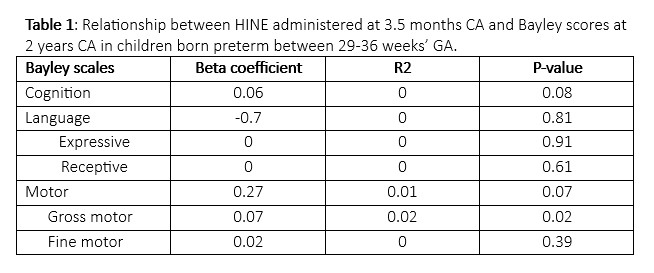Developmental and Behavioral Pediatrics
Session: Developmental and Behavioral Pediatrics 3: Screening
415 - Predicting developmental delay in children born between 29 and 36-weeks of gestation: Utility of the Hammersmith Infant Neurological Examination
Friday, May 3, 2024
5:15 PM - 7:15 PM ET
Poster Number: 415
Publication Number: 415.332
Publication Number: 415.332

Léanne Brabant, M.Sc (she/her/hers)
OT
Universite de Montreal Faculty of Medicine
Montréal, Quebec, Canada
Presenting Author(s)
Background: The Hammersmith Infant Neurological Examination (HINE) is a widely used neurological assessment tool designed to improve earlier diagnosis of cerebral palsy. Some studies suggest a relationship between the HINE score and long-term cognitive and motor performance in very preterm infants or those with hypoxic-ischemic encephalopathy. Evidence of the performance of the HINE for children born preterm between 29-36 weeks of gestational age (GA) is scarce.
Objective: To examine the association between the HINE score at 3.5 months corrected age (CA) and developmental delay (motor, cognitive or language) at 2 years CA in preterm children born between 29-36 weeks’ GA.
Design/Methods: This is a longitudinal observational study which recruited 241 infants born between 29-36 weeks’ GA who were admitted for at least 48 hours in the neonatal intensive care unit. The HINE was performed by a single assessor at 3.5 months CA. The Bayley scales of infant and toddler development, 4th edition (Bayley), were administered by trained individuals blinded to HINE scores, at 2 years CA. Relationships between HINE and Bayley scores were calculated using linear regression analyses.
Results: 160 infants were included in the analyses. Mean HINE score at 3.5 months CA was 62±4. Mean Bayley cognitive, language and motor standard scores were 97±12, 93±17 and 97±9, respectively, with developmental delay (Bayley score < 85) identified in 12%, 28%, and 10%, respectively. Table 1 displays the relationship between HINE and Bayley scores.
Conclusion(s): The HINE total score at 3.5 months CA is not associated with Bayley cognition and language developmental score for children born preterm between 29-36 weeks GA. However, the HINE total score is associated with gross motor development score at 2 years CA for children born preterm between 29-36 weeks GA.

